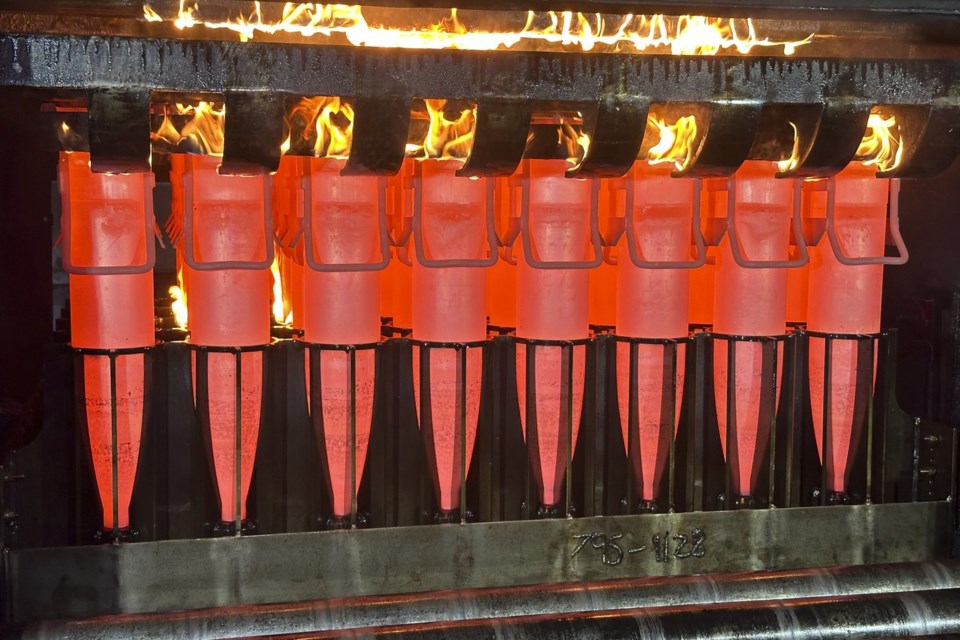WASHINGTON (AP) ‚ÄĒ The American economy expanded at a healthy 3% annual pace from April through June, boosted by strong consumer spending and business investment, the government said Thursday, leaving its previous estimate unchanged.
The Commerce Department reported that the nation's gross domestic product ‚ÄĒ the nation's total output of goods and services ‚ÄĒ picked up sharply in the second quarter from the tepid 1.6% annual rate in the first three months of the year.
Consumer spending, the primary driver of the economy, grew last quarter at a 2.8% pace, down slightly from the 2.9% rate the government had previously estimated. Business investment was also solid: It increased at a vigorous 8.3% annual pace last quarter, led by a 9.8% rise in investment in equipment.
The third and final GDP estimate for the April-June quarter included figures showing that inflation continues to ease, to just above the Federal Reserve‚Äôs 2% target. The central bank‚Äôs favored inflation gauge ‚ÄĒ the personal consumption expenditures index, or PCE ‚ÄĒ rose at a 2.5% annual rate last quarter, down from 3.4% in the first quarter of the year. Excluding volatile food and energy prices, so-called core PCE inflation grew at a 2.8% pace, down from 3.7% from January through March.
The U.S. economy, the world's biggest, displayed remarkable resilience in the face of the 11 interest rate hikes the Fed carried out in 2022 and 2023 to fight the worst bout of inflation in four decades. Since peaking at 9.1% in mid-2022, annual inflation as measured by the consumer price index has .
Despite the surge in borrowing rates, the economy kept growing and employers kept hiring. Still, the job market has shown signs of weakness in recent months. From June through August, America's employers added an average of just 116,000 jobs a month, the lowest three-month average since mid-2020, when the COVID pandemic had paralyzed the economy. The unemployment rate has ticked up from a half-century low 3.4% last year to 4.2%, still relatively low.
Last week, responding to the steady drop in inflation and growing evidence of a more sluggish job market, the Fed by an unusually large half-point. The rate cut, the Fed’s first in more than four years, reflected its new focus on shoring up the job market now that inflation has largely been tamed.
“The economy is in pretty good shape,’’ Bill Adams, chief economist at Comerica Bank, wrote in a commentary.
“After a big rate cut in September and considerable further cuts expected by early 2025, interest-rate-sensitive sectors like housing, manufacturing, auto sales, and retailing of other big-ticket consumer goods should pick up over the next year. Lower rates will fuel a recovery of job growth and likely stabilize the unemployment rate around its current level in 2025.’’
Several barometers of the economy still look healthy. Americans last month , for example, suggesting that consumers are still able and willing to spend more despite the cumulative impact of three years of excess inflation and high borrowing rates. The nation’s . The pace of rose sharply from the pace a year earlier.
And this month, consumer sentiment rose for a third straight month, according to preliminary figures from the . The brighter outlook was driven by ‚Äúmore favorable prices as perceived by consumers‚ÄĚ for cars, appliances, furniture and other long-lasting goods.
A category within GDP that measures the economy’s underlying strength rose at a solid 2.7% annual rate, though that was down from 2.9% in the first quarter. This category includes consumer spending and private investment but excludes volatile items like exports, inventories and government spending.
Though the Fed now believes inflation is largely defeated, many Americans with still-high prices for groceries, gas, rent and other necessities. Former President Donald Trump blames the Biden-Harris administration for sparking an inflationary surge. Vice President Kamala Harris, in turn, has charged that Trump’s promise to slap tariffs on all imports would raise prices for consumers even further.
On Thursday, the Commerce Department also issued revisions to previous GDP estimates. From 2018 through 2023, growth was mostly higher ‚ÄĒ an average annual rate of 2.3%, up from a previously reported 2.1% ‚ÄĒ largely because of upward revisions to consumer spending. The revisions showed that GDP grew 2.9% last year, up from the 2.5% previously reported.
Thursday’s report was the government’s third and final estimate of GDP growth for the April-June quarter. It will release its initial estimate of July-September GDP growth on Oct. 30. A forecasting tool from the Federal Reserve Bank of Atlanta projects that the economy will have expanded at a 2.9% annual pace from July through September.
___
This story has been corrected to show that PCE inflation rose at a 3.4% annual rate in the first quarter, not 3%.
Paul Wiseman, The Associated Press


